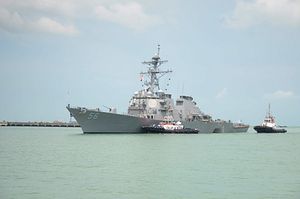The USS John S. McCain, damaged in a collision with a merchant tanker entering the Singapore Strait in August, has been patched up and departed the Changi Naval Base in Singapore to return to its homeport of Yokosuka, Japan to be repaired. This contrasts with her sister ship, the USS Fitzgerald, who was damaged in another collision with a container ship south of Tokyo Bay in June, and is being returned to a shipyard in the United States for repairs. Both ships suffered flooding in berthing compartments that killed seventeen sailors, seven on the Fitzgerald and ten on the McCain.
After making its way to deep water, the McCain will be picked up by a heavy lift ship, the MV Treasure, which will partially submerge and then lift the destroyer out of the water by rising beneath it, and deliver it back to the U.S. Naval base in Yokosuka, Japan.
Yokosuka has a U.S. Navy-run ship repair facility centered around century-old drydocks originally constructed to build battleships for the early Imperial Japanese Navy and now provide maintenance for ships of the U.S. Seventh Fleet.
The U.S. Navy opted to return the USS Fitzgerald to the Huntington Ingalls shipyard in Pascagoula, Mississippi, also via heavy lift ship. The Ingalls yard is one of the two contractor shipyards that builds complete Arleigh Burke-class destroyers like the Fitzgerald and McCain; the Fitzgerald was constructed in the other yard, Bath Iron Works, in Maine, in 1993.
While both ships were pierced beneath the waterline by the bulbous bows of the merchant ships that struck them, the Fitzgerald also suffered extensive damage to her superstructure, including the sensitive SPY radar arrays that are the centerpiece of the destroyers’ combat system and enables them to track aircraft, supersonic sea-skimming cruise missiles, and ballistic missiles. The additional structural damage and damage to electronic combat systems will make the Fitzgerald’s repairs more extensive and more expensive, at least $370 million and taking at least a year, and probably more. When repairs are complete it will likely take another year for the crew to retrain and recertify to be ready to deploy.
The McCain’s damage was more limited to structural and mechanical spaces, as well as the berthing space where ten sailors drowned, and should cost about $220 million to fix. Accodording to the U.S. Navy, by staying in Yokosuka, the McCain’s crew will be able to better maintain their training and certifications, enabling the destroyer to be deployment-ready faster.
The Fitzgerald and McCain have been forward deployed to Japan for years and their crews are have extensive experience in the Western Pacific, where the U.S. Navy is engaged everywhere from North Korea to patrolling the South China Sea amid expanding Chinese presence and assertiveness. As a result of the Japan-based ships’ high operational tempo, there is widespread concern that training standards slipped in order to keep them at-sea, but it is unclear that the spate of mishaps in the Pacific over the past year can be conclusively linked to those training practices.
Regardless of the root causes discovered by the investigations still ongoing, the collisions have left the U.S. Seventh Fleet short two ballistic missile defense-capable destroyers at a time of increasing tensions, particularly around North Korea’s nuclear program. The Navy has said that it will meet all its ballistic missile defense requirements in the region, meaning operations elsewhere will likely have to go unfilled.

































